Crypto Markets Buckle Under Geopolitical Pressure as Bitcoin Dips Below $106K
A wave of geopolitical tensions and disappointing macro data triggered a sharp sell-off in digital assets Thursday evening, even as U.S. equities managed to close in the green.
Bitcoin (BTC) dropped over 2.5% in the past 24 hours, slipping below $106,000, while Ether (ETH), Solana (SOL), XRP, and Dogecoin (DOGE) all posted losses between 5% and 7%. The pullback accelerated during the U.S. evening session, marking a notable decoupling from traditional markets.
Macro Headwinds Mount: Trump’s Tariff Threats and Iran Concerns
Investors were on edge after U.S. President Donald Trump signaled the possibility of renewed tariffs as trade negotiations with China near a July deadline. Simultaneously, escalating tensions with Iran added to the market’s jitters.
“We’ve told Americans to leave [the region],” Trump said at the White House. “I don’t want to say it’s imminent, but things could escalate fast.”
Markets interpreted these statements as raising the risk of direct military confrontation in the Middle East, a scenario with unpredictable ripple effects across global assets.
Economic Data Adds to Unease, Fed Pressure Builds
Thursday also brought softer-than-expected U.S. Producer Price Index (PPI) data and persistent job market weakness. Initial jobless claims remained at 248,000, while continuing claims hit 1.956 million, their highest level since 2021.
With signs of slowing growth accumulating, pressure is mounting on the Federal Reserve to pivot. Trump, for his part, again took aim at Fed Chair Jerome Powell, calling him a “numbskull” and implying he may intervene to push for rate cuts.
Digital Assets Suffer as Risk Premium Widens
Unlike equities, crypto appears to be pricing in more immediate risk from both geopolitical and monetary uncertainty.
“Crypto markets are hypersensitive to both dollar liquidity and global instability,” said one analyst. “That’s a double-bind right now.”
Despite the decline, some traders see room for optimism. With inflation cooling and Fed rate cuts increasingly priced in, others argue that the sell-off may prove short-lived — especially if volatility subsides and institutional inflows resume.





